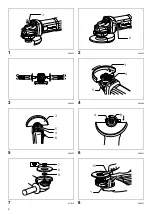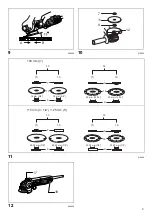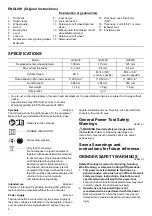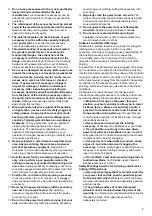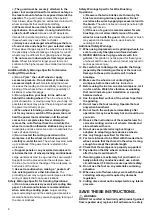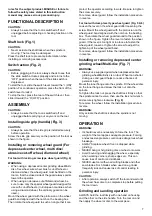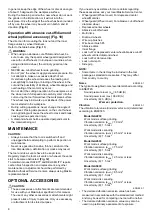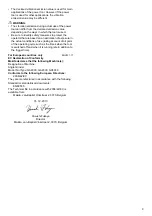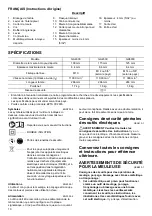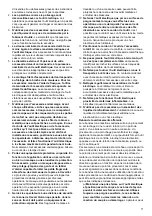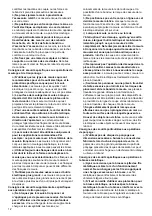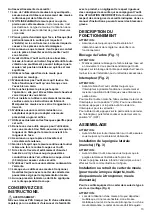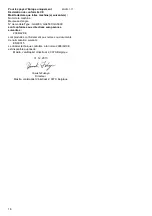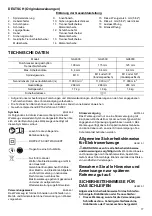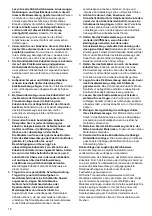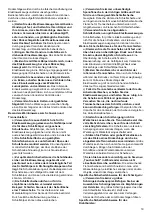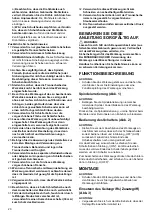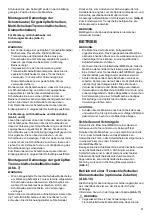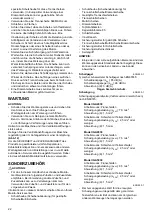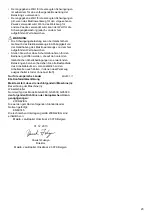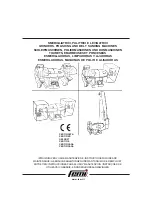
8
In general, keep the edge of the wheel or disc at an angle
of about 15 degrees to the workpiece surface.
During the break-in period with a new wheel, do not work
the grinder in the B direction or it will cut into the
workpiece. Once the edge of the wheel has been rounded
off by use, the wheel may be worked in both A and B
direction.
(Fig. 9)
Operation with abrasive cut-off/diamond
wheel (optional accessory) (Fig. 10)
The direction for mounting the lock nut and the inner
flange varies by wheel thickness.
Refer to the table below.
(Fig. 11)
WARNING:
• When using an abrasive cut-off/diamond wheel, be
sure to use only the special wheel guard designed for
use with cut-off wheels. (In European countries, when
using a diamond wheel, the ordinary guard can be
used.)
• NEVER use cut-off wheel for side grinding.
• Do not “jam” the wheel or apply excessive pressure. Do
not attempt to make an excessive depth of cut.
Overstressing the wheel increases the loading and
susceptibility to twisting or binding of the wheel in the
cut and the possibility of kickback, wheel breakage and
overheating of the motor may occur.
• Do not start the cutting operation in the workpiece. Let
the wheel reach full speed and carefully enter into the
cut moving the tool forward over the workpiece surface.
The wheel may bind, walk up or kickback if the power
tool is started in the workpiece.
• During cutting operations, never change the angle of
the wheel. Placing side pressure on the cut-off wheel
(as in grinding) will cause the wheel to crack and break,
causing serious personal injury.
• A diamond wheel shall be operated perpendicular to
the material being cut.
MAINTENANCE
CAUTION:
• Always be sure that the tool is switched off and
unplugged before attempting to perform inspection or
maintenance.
• Never use gasoline, benzine, thinner, alcohol or the
like. Discoloration, deformation or cracks may result.
The tool and its air vents have to be kept clean.
Regularly clean the tool’s air vents or whenever the vents
start to become obstructed.
(Fig. 12)
To maintain product SAFETY and RELIABILITY, repairs,
carbon brush inspection and replacement, any other
maintenance or adjustment should be performed by
Makita Authorized Service Centers, always using Makita
replacement parts.
OPTIONAL ACCESSORIES
CAUTION:
• These accessories or attachments are recommended
for use with your Makita tool specified in this manual.
The use of any other accessories or attachments might
present a risk of injury to persons. Only use accessory
or attachment for its stated purpose.
If you need any assistance for more details regarding
these accessories, ask your local Makita Service Center.
• Wheel guard (Wheel cover) For depressed center
wheel/Multi disc
• Wheel guard (Wheel cover) For abrasive cut-off wheel/
diamond wheel
• Depressed center wheels
• Abrasive cut-off wheels
• Multi discs
• Diamond wheels
• Wire cup brushes
• Wire bevel brush 85
• Abrasive discs
• Inner flange
• Lock nut For depressed center wheel/abrasive cut-off
wheel/multi disc/diamond wheel
• Lock nut For abrasive disc
• Lock nut wrench
• Side grip
NOTE:
• Some items in the list may be included in the tool
package as standard accessories. They may differ
from country to country.
Noise
ENG905-1
The typical A-weighted noise level determined according
to EN60745:
Sound pressure level (L
pA
): 85 dB (A)
Sound power level (L
WA
): 96 dB (A)
Uncertainty (K): 3 dB (A)
Wear ear protection.
Vibration
ENG900-1
The vibration total value (tri-axial vector sum) determined
according to EN60745:
Model GA4030
Work mode: surface grinding
Vibration emission (a
h,AG
): 7.0 m/s
2
Uncertainty (K): 1.5 m/s
2
Work mode: disc sanding
Vibration emission (a
h,DS
): 2.5 m/s
2
or less
Uncertainty (K): 1.5 m/s
2
Model GA4530
Work mode: surface grinding
Vibration emission (a
h,AG
): 7.5 m/s
2
Uncertainty (K): 1.5 m/s
2
Work mode: disc sanding
Vibration emission (a
h,DS
): 2.5 m/s
2
or less
Uncertainty (K): 1.5 m/s
2
Model GA5030
Work mode: surface grinding
Vibration emission (a
h,AG
): 8.5 m/s
2
Uncertainty (K): 1.5 m/s
2
Work mode: disc sanding
Vibration emission (a
h,DS
): 2.5 m/s
2
or less
Uncertainty (K): 1.5 m/s
2
ENG902-1
• The declared vibration emission value has been
measured in accordance with the standard test method
and may be used for comparing one tool with another.
• The declared vibration emission value may also be
used in a preliminary assessment of exposure.


